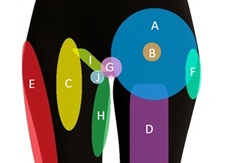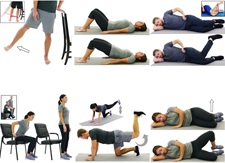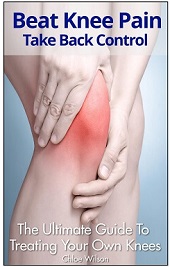- Home
- Hip Pain Diagnosis
- Hip Tendonitis
Hip Tendonitis
Written By: Chloe Wilson, BSc(Hons) Physiotherapy
Reviewed by: KPE Medical Review Board
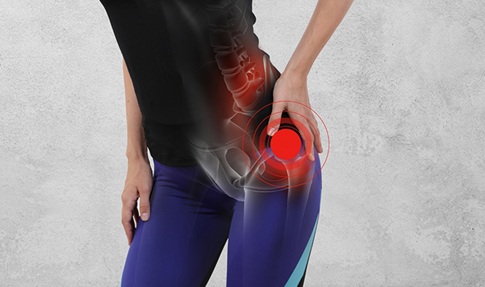
Hip tendonitis is a common problem causing pain and irritation around the hip and upper thigh.
It is typically an overuse injury causing pain during hip and leg movements or after activity.
There are four main types of tendonitis of the hip, depending on which tendon is affected, each causing pain in slightly different places.
Tendonitis in the hip is a common condition that can affect people of all ages and activity levels, but when caught early, it is highly treatable.
In this guide, we will look at what hip tendonitis is, what causes it, symptoms and diagnosis, and the best ways to treat it, including simple exercises and prevention tips to help you stay active and pain-free.
What Is Hip Tendonitis?
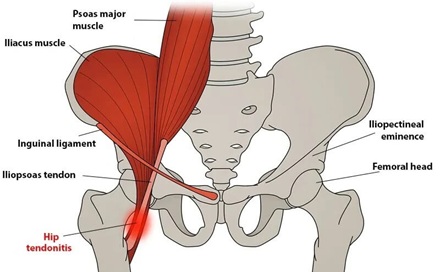
Hip tendonitis, also referred to as hip tendinopathy or tendonitis in the hip, is an overuse injury that causes inflammation or irritation of the tendons around the hip joint.
Tendons are the tough connective tissues that attach the hip muscles to bone, and when they are overloaded or injured, they can become painful and swollen.
Repetitive overloading or stress through the tendon leads to microscopic tearing and disorientation of the tendon fibres. This leads to weakening and inflammation in the tendon. Tendons are notoriously slow to heal as they typically have a limited blood supply.
While “hip tendonitis” refers to inflammation (usually an acute phase), “hip tendinopathy” is often used to describe more chronic tendon changes, including degeneration and thickening.
Types of Hip Tendonitis
There are several different tendons around the hip that can develop tendonitis. The most common types of hip tendonitis are:
1. Hip Flexor Tendonitis
Hip flexor tendonitis affects the tendons at the front of the hip, most commonly iliopsoas tendonitis. It is common in athletes, dancers, and anyone who does repetitive hip flexion e.g. running or kicking
2. Gluteal Tendonitis
Gluteal tendonitis typically causes outer hip pain especially when lying on your side, walking or climbing stairs. It may develop in any of the three gluteal tendons, the most common being gluteus medius tendonitis. It is especially common in runners and women over 40 and is sometimes mistaken for ischial bursitis.
3. Hamstring Tendonitis
Proximal hamstring tendonitis typically presents as pain in the lower buttock or back of the hip, and is often aggravated by prolonged sitting or sprinting. You can also get distal hamstring tendonitis at the back of the knee.
4. Adductor Tendonitis
Adductor tendonitis affects the tendons in the groin area. It causes inner thigh pain and groin pain, and is common in footballers and those doing side-to-side movements. NB Not the same as a groin strain where there is overstretching of one of the adductor muscles
5. ITB Tendonitis
The iliotibial band is a thick band of fascia rather than a tendon. When irritated, iliotibial band syndrome can cause outer hip pain and friction over the greater trochanter or pain down to the knee.
Each type of tendonitis in the hip has slightly different symptoms depending on the location, but they all result from similar mechanisms.
Causes of Hip Tendonitis
Tendonitis of the hip is usually the result of repetitive stress or overloading of one of the hips tendons without sufficient rest time to recover. Common causes of hip tendinopathy include:
- Overuse from repetitive activities like running, cycling, or stair climbing
- Sudden increase in activity levels e.g. returning to sport after time off or taking up a new sport
- Muscle imbalances that cause some muscles to overwork while others underperform. There is often a combination of muscle weakness and tightness
- Poor biomechanics or posture, especially with walking or running
- Age-related degeneration, where tendons become less resilient over time
Symptoms of Hip Tendonitis
The symptoms of hip tendinopathy vary slightly depending on which tendon is affected, but the general signs to watch out for include:
- Pain Around The Hip Joint: typically localised to the front (hip flexor tendonitis), outer side (gluteal tendonitis or ITB syndrome), inner side (adductor tendonitis) or back of the hip (hamstring tendonitis) that worsens when stretching or contracting the involved muscle
- Pain That Worsens With Activity: especially repetitive movements
- Tenderness: when pressing over the affected tendon
- Stiffness: and reduced hip range of motion after periods of rest or in the morning that eases with gentle movement
- Weakness: or reduced endurance in the surrounding muscles
- Clicking: or snapping sensation with movement may occur
- Difficulty Sleeping: from hip pain at night either waking you up or stopping you getting to sleep
Hip tendonitis pain may start as a dull ache and gradually worsen to more of a stabbing or burning pain if the underlying issue is not addressed.
Hip Tendonitis Diagnosis
Diagnosing tendonitis in the hip starts with a thorough history and physical exam. A physiotherapist or doctor will look for patterns of pain and movement that suggest tendon involvement.
What to expect in a clinical assessment:
- Discussion of symptoms, activity levels, and aggravating movements
- Palpation of the hip to identify areas of tenderness
- Range of motion tests to see if pain occurs during stretching
- Strength testing, particularly of the glutes, hip flexors, or hamstrings
- Functional movements like squats or walking to assess biomechanics
Your doctor may send you for imaging studies to confirm the diagnosis or rule out other conditions, such as:
- Ultrasound: Good for identifying tendon inflammation or tears
- MRI: Provides more detail if symptoms persist or are severe
- X-ray: Generally used to rule out other issues like arthritis or bone spurs
Differential Diagnosis
There are a number of other conditions that can present with similar symptoms to hip tendonitis:
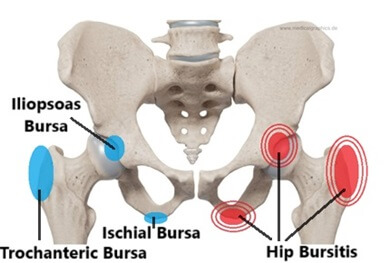
- Hip Bursitis: inflammation of one of the fluid filled sacs around the hip
- Hip Labral Tears: damage to the ring of cartilage that lines the hip socket
- Hip Impingement: abnormal bone shape causes problems with hip movement
- Groin Strain: overstretching of one of the adductor muscles on the inner thigh
- Hernia: usually causes a palpable lump in the front or inner side of the hip
- Referred Pain: from problems in the lower back
#CommissionsEarned from Amazon on qualifying purchases
Treatment for Hip Tendonitis
Treating hip tendonitis is all about reducing pain, promoting healing, and correcting the underlying issues that caused the problem in the first place. The goal is to get you moving comfortably again, and to prevent the pain from coming back.
1. Rest and Activity Management
The best place to start when treating hip tendonitis is to rest from aggravating activities. While it might sound tempting to completely stop all activity, total rest can actually slow healing and cause muscle weakness. Instead, aim to:
- Modify activities that worsen symptoms. For example, reduce or temporarily take a break from running, jumping, or hill climbing.
- Make sure you have rest days between training sessions to allow the muscles and tendons time to recover
- Avoid sudden changes in activity levels. Gradually build up intensity and duration once pain improves.
- Incorporate low-impact exercise like swimming, cycling, or walking on flat surfaces to maintain fitness without overloading the hip.
- Listen to your body. If an activity causes sharp pain or worsens symptoms the next day, reduce the intensity or duration.
2. Ice and Anti-inflammatories
Managing inflammation and pain early on helps speed up recovery with hip tendonitis:
- Ice: Apply an ice pack wrapped in a towel over the painful area for 15–20 minutes, 2-3 times per day, especially after activity.
- Anti-Inflammatory Medications: Non-steroidal anti-inflammatory drugs (NSAIDs), like ibuprofen, can help reduce pain and swelling in the short term. However, they should not be used long-term without medical advice.
3. Physiotherapy and Rehab
Physical therapy is the cornerstone of hip tendonitis treatment. A tailored program can help restore strength, flexibility, and movement patterns:
- Hip Strengthening Exercises: Focus on weak muscles that support
the hip joint, especially glute strengthening, hip flexor strengthening,
hamstrings strengthening, and core muscle work. Examples include clamshells,
side-lying leg lifts, bridges, and resistance band work
- Hip Stretching Exercises: It is really important to stretch
tight muscles that might be placing extra strain on the tendons, such as hip
flexors, IT band, and adductors. Gentle, sustained hip stretches can improve
mobility and reduce tension
- Eccentric Loading: For chronic tendinopathy, eccentric
exercises where you work the muscle as it lengthens rather than as it shortens, like
slow, controlled lowering movements have strong evidence for tendon healing
- Manual Therapy: Hands-on techniques by your therapist such as
joint mobilisation and deep transverse friction massage can help improve joint
mobility, reduce muscle tightness, and promote circulation and healing with hip
tendinopathy
- Gradual Return To Activity: Your therapist will guide you through progressively increasing activity loads while monitoring symptoms to make sure symptoms don not return

4. Shockwave Therapy and Dry Needling
For stubborn or long-standing tendon issues, adjunct therapies can be beneficial:
- Extracorporeal Shockwave Therapy (ESWT): This uses sound waves to stimulate healing in damaged tendons. It can reduce pain and improve function after a few sessions.
- Dry Needling: Involves inserting fine needles into trigger points or tendon tissue to promote blood flow and reduce muscle tightness.
5. Injections
In some cases where conservative hip tendonitis treatments are not enough, injections may be considered:
- Corticosteroid injections: Can reduce inflammation and pain temporarily but don’t address the underlying tendon health and can weaken tendons if used repeatedly
- Platelet-Rich Plasma (PRP) injections: These involve injecting concentrated growth factors from your own blood to promote tendon repair. Some patients benefit from PRP, especially with chronic hip tendinopathy, but evidence is still evolving
Injections are usually a last resort and should be discussed carefully with a specialist as they temporarily weaken the tendon, risking further damage. Injections should always be used alongside other hip tendonitis treatments rather than in isolation.
6. Surgery
Hip tendonitis surgery is rare and is generally reserved for cases where tendon damage is severe or symptoms fail to improve after 6-12 months of conservative care. Procedures may include:
- Tendon repair or debridement (removal of damaged tissue)
- Release of tight structures compressing the tendon
- Addressing related hip joint problems if present e.g. labral tears
Surgical recovery involves a structured rehab program and can take several months.
Practical Tips to Support Your Recovery
Here are some of our top tips to help you make the best recovery from hip tendonitis:
- Stay consistent with your rehab exercises. This is key to healing and preventing recurrence.
- Avoid “too much too soon.” Gradually increase your activity levels to avoid flares.
- Pay attention to footwear and surfaces, especially if you run or walk a lot. Good support and softer surfaces can reduce impact.
- Maintain overall fitness with cross-training and low-impact activities.
- Address posture and movement habits that might have contributed to the problem.
If you tackle hip tendonitis early with the right treatment and rehab plan, you can expect a good recovery and a return to your normal activities, usually within a few weeks to months depending on severity. If symptoms persist, seeing a physiotherapist or healthcare professional for a personalized assessment is always a good idea.
Hip Tendonitis Summary
Hip tendonitis is a common condition caused by overuse, poor biomechanics, or muscle imbalances. It leads to pain, stiffness, and weakness and reduced hip range of motion, often aggravated by activity.
There are different types of hip tendinopathy, depending on which muscle is affected:
- Hip Flexor Tendonitis: front of hip pain
- Gluteal Tendonitis: outer hip pain
- Hamstring Tendonitis: back of hip pain
- Adductor Tendonitis: inner hip and thigh pain
- ITB Syndrome: outer hip and thigh pain
The good news is that tendonitis of the hip is highly treatable with the right combination of rest, strengthening and stretching exercises, and movement correction. Early diagnosis and a structured approach can get you back to your normal activities, without any ongoing nagging pain.
If you are experiencing hip tendonitis symptoms, don’t ignore them. The sooner you address the cause, the easier your recovery will be.
You may also be interested in the following articles:
- Front Hip Pain
- Outer Hip Pain
- Inner Thigh Pain
- Upper Thigh Pain
- Groin Strain
- Snapping Hip Syndrome
- Hip Muscle Anatomy
- Knee Pain Diagnosis Chart
Related Articles
Hip Pain At Night
October 2nd, 2025
Hip Pain Diagnosis
September 16, 2025
Hip Strengthening
September 24, 2025
Medical & Scientific References
- Current And Future Advances In Practice: Tendinopathies Of The Hip. Rheumatology Advances In Practice
- Conservative Management Of Tendinopathies Around Hip. Muscles, Ligaments & Tendons Journal
- Current Understanding Of The Diagnosis And Management Of The Tendinopathy: An Update From The Lab To The Clinical Practice. Disease A Month Journal
Last Updated: November 3rd, 2025
Next Review Due: November 3rd, 2027

